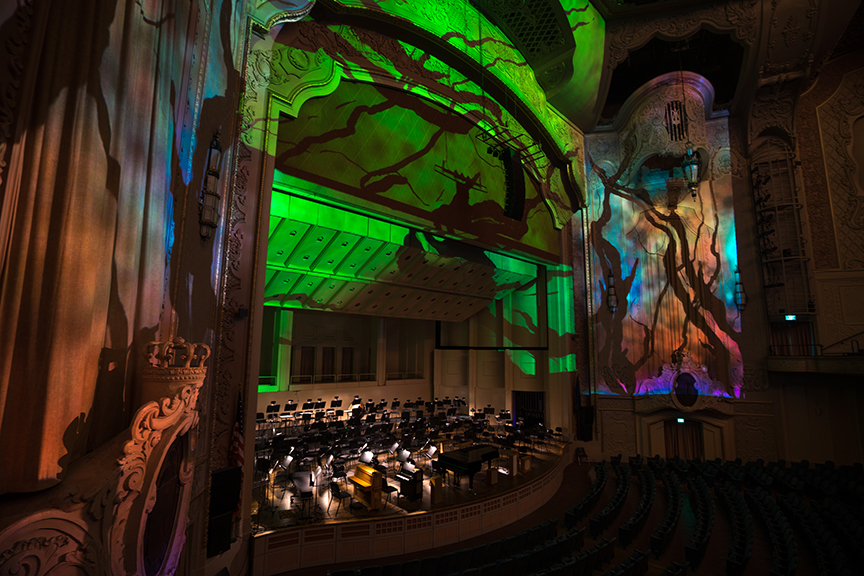Rose Bond’s Vision for Turangalîla
November 30, 2016

The recording of the symphony plays in the darkened room, and a hand-drawn bird flies across above the stage of a 3-foot tall scale model of the Schnitzer Concert Hall in a basement gallery in PNCA. Moments later, in response to a turn in the music, water pours down one of the concert hall walls.
Rose Bond, lead faculty of our Animated Arts program is hard at work with her technical director Steve Farris. Farris is seated behind a row of computer monitors that control a number of projectors trained on the scale model. Bond energetically moves around behind him, describing the process by which she, Farris, video mapper Andrew Wade Smith and a team of student and alumni animators have been constructing an animated piece that will be video mapped on the concert hall and performed live during the Oregon Symphony’s December 2016 production of Messiaen’s Turangalîla, part of the symphony’s SoundSights Series. Bond calls Turangalîla a “monster of a piece.” The award-winning Bond will project video animation across the concert hall in real-time during the concert using seven computers and six projectors.
Bond has said about the distinction between the animation work that she does and what a traditional audience might think of when they hear the word animation, “I see animation as a way to choreograph time.” A particular challenge of this work is that usually in a video or film work, the image comes first with the sound to follow. In this case, the usual order of production is reversed with the sound existing prior to any image. Bond notes, this is the symphony’s Soundsights Series not “sight sound series.”
Bond has been working on the project for over a year and took a moment recently to tell us about the experience.
LR: Thank you for letting me visit your staging space. Can you tell me what is happening here? What Steve is doing?
RB: The piece is 80 minutes on four screens. Steve is using this software called WatchOut that synchronizes all four videos so that the performance can be live mixed. Everything is cued, but we will be performing live along with the orchestra. The assistant conductor and I will be in the booth, looking at wave forms during the performance to cue video.
From the beginning, we have been listening to this symphony as played by other orchestras. We have been listening to one from Paris, now one from Berlin and Helsinki, and they are all slightly different. It’s live. Movement one might be twenty seconds longer or shorter. This is very different than scoring for a film. It’s scoring for live performance.
LR: How long have you been working on this?
RB: I began working on the project in fall of 2015, so it will have been about a year. The students and alumni began working on it in spring.
I put out a call to students and alumni and selected 10 including students from Animated Arts, Intermedia, and Video and Sound. This was in spring right before the end of the semester. We met bi-weekly, listened to music, responded as a group. Working throughout the summer, they came up with segments that vary from fairly short to a full movement length.
Micah Weber [an alumnus] is carrying a movement and it’s exquisite. Along with Weber, the piece includes works by John Sommerson, Makai Mendiola, Joseph Wells, Kathryn McAnalley, Ari Stramel, Arianna Gazca, Grayson Bear, Sarah Hickey, Carla Mielnik, Teagan Smiley-Wolfe.
It was important to me that students weren’t going to do it for free. So we built into the budget a stipend for each student.
LR: I know the students worked on this all summer. What was the process like?
RB: Well a lot of it early on was encouraging students to do the research. The point of departure was this mid-century, avant-garde piece. We looked at what was going in on in visual art and moving image at this time. It’s brooding music, an ode to love, full of loss. And it’s autobiographical, as Messian had lost his first wife and then fallen in love with his pianist. We also looked back at German Expressionism, at films such as The Cabinet of Dr. Caligari, Metropolis, looking at this dark place.
It was a really great opportunity for different styles, for people to bring a lot to it because it’s overwhelmingly complex. There are tender sequences, strong overbearing moments, joyous rhapsody kind of stuff, and this sci-fi element. There’s a theremin in the piece!
LR: And then you are knitting together the elements.
RB: Yes, in some movements more than others. And then preparing the mapping and preparing for the live performance. Translating this [the scale model projection] into the Schnitz.
LR: Of course you’ve done this type of large-scale video mapped projection a number of times.
RB: Yes, but this is different because it is happening in the moment. It’s very exciting. The piece is very moving.
The Oregon Symphony performs Turangalîla December 3-5 at Arlene Schnitzer Concert Hall in Portland, Oregon. More information and tickets.
Here is a video preview and conversation Bond had with conductor Carlos Kalmar and Director of the Portland Art Museum, Brian Ferriso. It offers, about 20 minutes in, previews of the animated works. It includes an overview of some of the large-scale projected works that Bond has developed over the years. And several students and alumni speak about their contributions to the project as well.